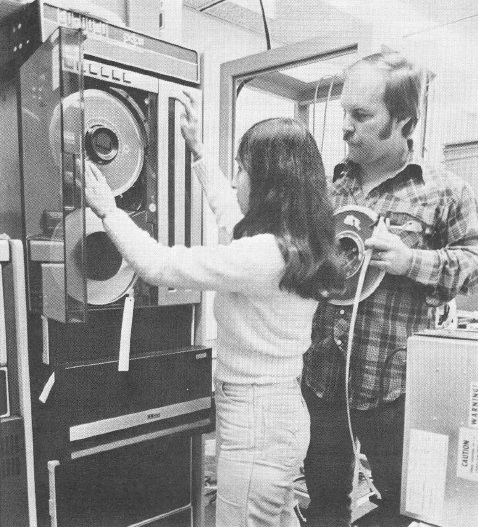New Hardware Enhances Data Acquisition Rates

Ignacia Cuevas and Jim Meadows prepare to test one of the new 6250 bpi tape drives before delivery to a data acquisition computer for one of the high energy physics experiments.
The size and complexity of the detectors used in Fermilab experiments have been growing rapidly. This growth has, in turn, placed increasing demands on the data-acquisition minicomputers--the devices that acquire the data from the experiment's detector and monitor the quality of the data. Two new kinds of hardware have been adopted by the Fermilab Computing Department to enhance the performance of these minicomputers.
The first new kind of hardware is a more flexible additional memory device called a "bank-switchable bulk memory." The bulk memory is organized in banks, any one of which can be switched into the computer for the temporary storage of data during the time beam reaches the experiment. By switching from bank to bank, it is possible to record more data than could be handled by the original minicomputer. Besides allowing for the storage of more data, the bulk memory allows data to be acquired at a higher rate. The first experiment to use this new hardware (E-516) achieved a data rate double that possible with their previous computer system.
A second experiment (E-537) is now preparing to use the bulk memory with its data acquisition minicomputer.
The second new kind of hardware is a high-density magnetic tape drive. Previous tape drives in operation at the Laboratory were capable of recording data at a density of 800 or 1600 bpi (bytes of data per inch of magnetic tape). The new tape drive records data at the much higher density of 6250 bpi. Tape drives are used by the data-acquisition minicomputers to make a copy of the experimental data for future analysis. Once the data has been copied to tape, the space that the data occupied in the minicomputer's memory can be filled with new data from the detector. By recording information at higher density, the new tape drives make it possible to copy the data onto tape at greater speed, allowing more data to be taken.
In order to incorporate these two new pieces of hardware, it has been necessary to update the software that makes use of them. This task was the work of Joe Biel and Bob Dosen. In addition, the hardware itself has required a significant amount of hardware development and testing. This was done in cooperation with the commercial vendors involved. The Fermilab portion of the hardware effort was carried out by the Computing Department Hardware Group under the direction of Rich Knowles and benefitted especially from the work of Jim Meadows.
Dick Adamo, Ignacia Cuevas, Bob Robinson, Larry Tate and Virgil West have all helped to keep the equipment operational for the individual experiments.
The hardware discussed here is most directly related to improving the quantity of data taken in the high energy physics experiments at the Laboratory. However, by freeing up memory in the minicomputer, these hardware devices also increase the ability of the computer to monitor the data. Thus, the new hardware helps the experimenter to see that the data is of the highest quality as well.


